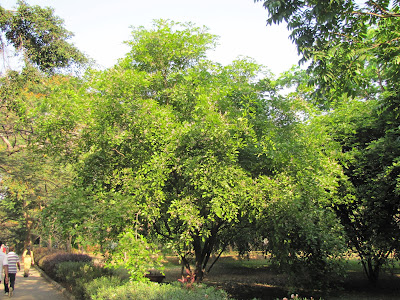I wasn't always obsessed with trees. I have always loved trees, but didn't care much about identifying them. Due to various reasons, some of which I am not even aware, I got interested in identifying trees. And I am pretty sure that my beloved MN Krishna Rao park provided the right atmosphere. Walking there every morning and taking my daughter to play there every evening, it did things to me. It is difficult not to be immune to the charms of trees, especially lovely, old, might trees. I think I started considering them my friends, and was ashamed that I couldn't name my friends, and so....
This spring, I have reached the peak of my obsession. That is why the article, the photographs....
My mania has rubbed off on Puttachi too...
S: Which one is honge, point it out to me....
Me: Wait, let me show you... it's a very beautiful tree...
Puttachi: (horrified) Amma, what are you saying? All trees are beautiful!
S: Which one is that?
Me: Tabebuia
S: But I thought Tabebuia is yellow....
Puttachi: (In an all-knowing tone) Papa, Tabebuia can be yellow and pink.
Attagirl!
For those of you who have been asking for more information, here are a few books and links:
Hasiru Honnu by BGL Swamy - A book in Kannada, it is an account of a field trip by a Biology class in a college. A very entertaining story, but with liberal doses of information on trees, their uses, their origins. An utter delight. This was one of the first books I read in Kannada.
Namma Maragalu by HR Krishnamurthy (Published by Karnataka Rajya Vijnana Parishat.) - Again in Kannada. This is just a straight, sincere account of common Indian trees. Very informative.
The problem with both the above books is that there are no photographs, only sketches. And it is not very easy for a newbie to relate the sketch to the actual tree/leaf.
This book - Indian Institute of Science - A Botanist's Delight - K.Sankara Rao solves that problem. Full of great photographs, with short writeups on all flowering trees, and even bushes and plants.
Updated: The Book of Indian Trees by K C Sahni, published by the Bombay Natural History Society - another good book about trees, with plenty of details, a lot of sketches and a few photographs (Thanks, Anu.)
Then, there are a couple of excellent online links that have pictures and information all in one.
Flowers of India
Flowering Trees-1 and Flowering Trees-2
Trees of India
Here I leave you with some more pictures from MN Krishna Rao park. By the way, all the photographs I have taken of flowering trees are from this one park!
Sausage Tree (courtesy Anu)This spring, I have reached the peak of my obsession. That is why the article, the photographs....
My mania has rubbed off on Puttachi too...
S: Which one is honge, point it out to me....
Me: Wait, let me show you... it's a very beautiful tree...
Puttachi: (horrified) Amma, what are you saying? All trees are beautiful!
S: Which one is that?
Me: Tabebuia
S: But I thought Tabebuia is yellow....
Puttachi: (In an all-knowing tone) Papa, Tabebuia can be yellow and pink.
Attagirl!
For those of you who have been asking for more information, here are a few books and links:
Hasiru Honnu by BGL Swamy - A book in Kannada, it is an account of a field trip by a Biology class in a college. A very entertaining story, but with liberal doses of information on trees, their uses, their origins. An utter delight. This was one of the first books I read in Kannada.
Namma Maragalu by HR Krishnamurthy (Published by Karnataka Rajya Vijnana Parishat.) - Again in Kannada. This is just a straight, sincere account of common Indian trees. Very informative.
The problem with both the above books is that there are no photographs, only sketches. And it is not very easy for a newbie to relate the sketch to the actual tree/leaf.
This book - Indian Institute of Science - A Botanist's Delight - K.Sankara Rao solves that problem. Full of great photographs, with short writeups on all flowering trees, and even bushes and plants.
Updated: The Book of Indian Trees by K C Sahni, published by the Bombay Natural History Society - another good book about trees, with plenty of details, a lot of sketches and a few photographs (Thanks, Anu.)
Then, there are a couple of excellent online links that have pictures and information all in one.
Flowers of India
Flowering Trees-1 and Flowering Trees-2
Trees of India
Here I leave you with some more pictures from MN Krishna Rao park. By the way, all the photographs I have taken of flowering trees are from this one park!



































